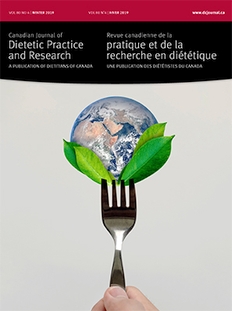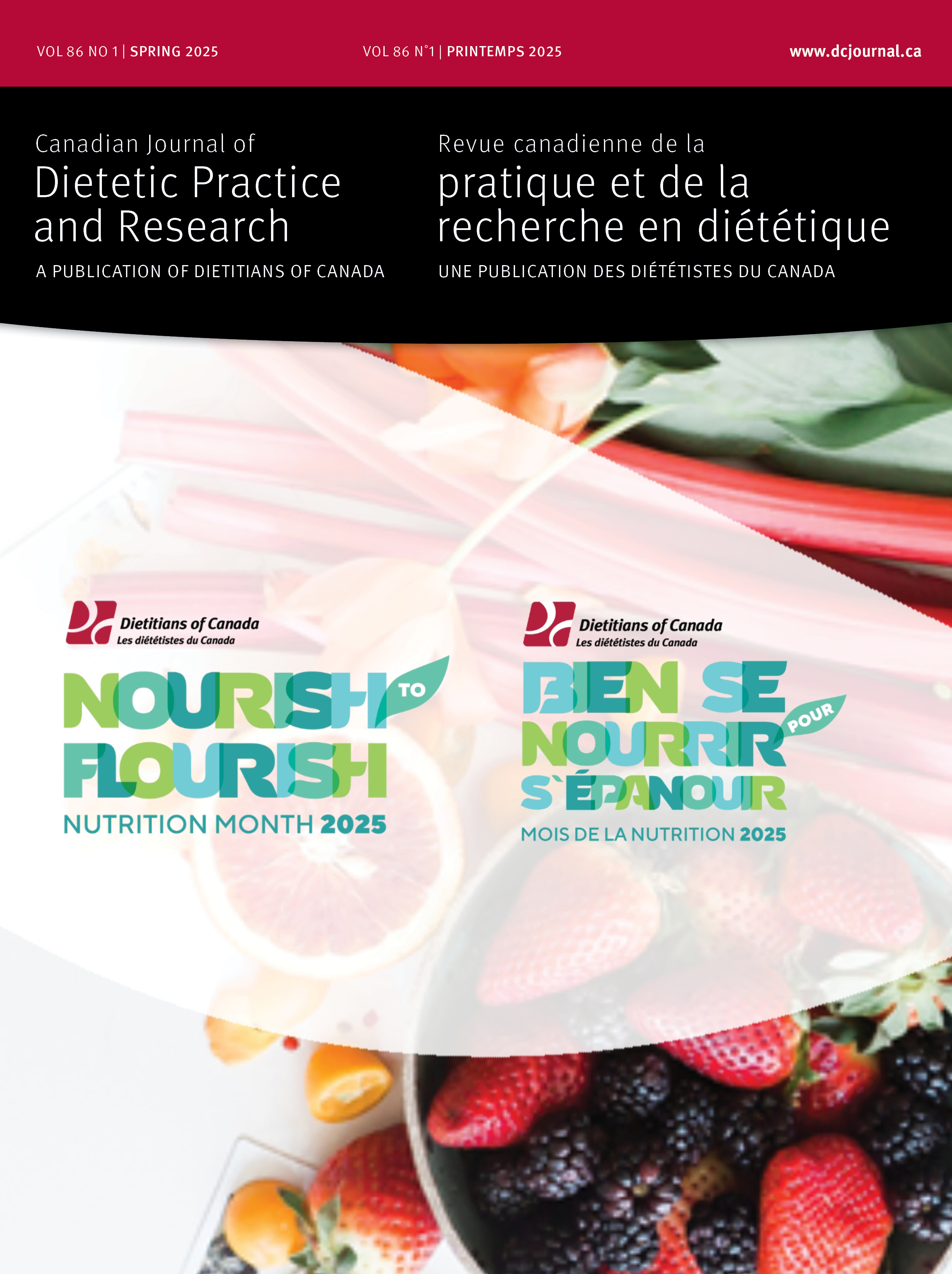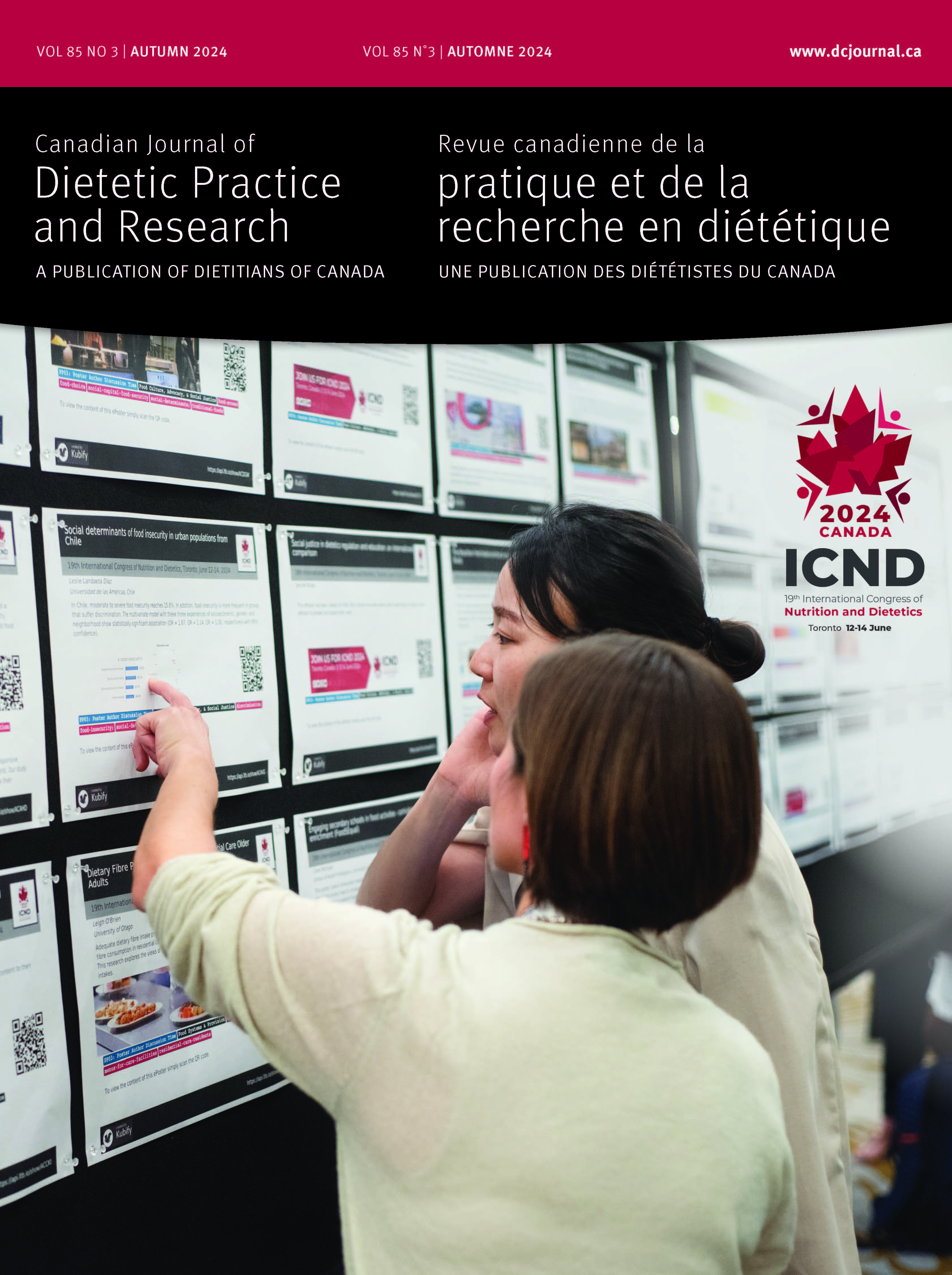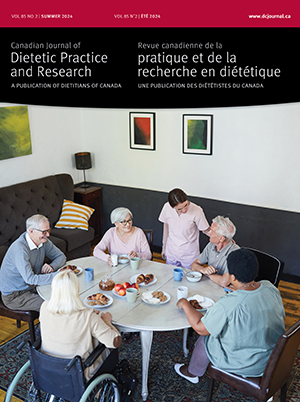Volume 80 • Number 4 • December 2019
Editor’s Message
Research
Purpose: In this paper, we begin to set out language defining sustainable food systems (SFS) in Canada, through the voices of dietitians, and identify leverage points where dietitians can affect change.Methods: Dietitians of Canada members were invited to a Delphi Inquiry process; questions explored a vision of SFS in Canada, barriers to that vision, and actions. Results were independently analysed by 2 members of the research team who used the Framework for Strategic Sustainable Development to structure the data.Results: Fifty-eight members participated. The resultant vision describes a future food system in 15 thematic areas of the social and ecological systems. Barriers are described according to how they undermine sustainability. High-leverage actions areas included: (i) facilitating knowledge development within the profession and public, (ii) influencing organizational policy to support SFS, and (iii) and influencing public policy. Approaches to such action included: (i) facilitating cross-sectoral collaboration and (ii) applying reflexive approaches.Conclusions: This research suggests a multidimensional understanding of food systems sustainability among dietitians. The vision provides some language to describe what dietitians mean by SFS and can be used as a compass point to orient action. Action areas and approaches have the potential to drive systemic change while avoiding unintended consequences.
Purpose: The purpose of this work was to assess Arab Muslim immigrant mothers’ acculturation level, to explore apparent links between acculturation level and experiences of dietary changes, and to gather information on factors affecting dietary acculturation.Methods: Semi-structured individual interviews focusing on food choices were conducted with 24 mothers who had been in Canada 5 years or more. An adapted version of an existing acculturation scale was used to assess participants’ perception of their own acculturation.Results: Arab Muslim mothers retain traditional food preparation. However, several factors led to changes in their daily food consumption such as children’s preferences, time concerns, and availability of Arabic food. No significant relation was found between measured levels of acculturation and the adoption of Canadian food behaviour or the retention of preparation and consumption of traditional foods (dietary acculturation); however, a greater length of stay in Canada was somewhat associated with limitations on preparing traditional food. The findings indicated that many of the Arab Muslim mothers interviewed retain important aspects of their traditional cuisine.Conclusions: Dietary acculturation for Arab Muslim immigrants to Canada involved a balance between carrying forward food-related traditions and adapting to Canadian culture, including Canada’s food culture.
Purpose: Milk products (fluid milk, cheese, yogurt) typically provide a rich source of calcium and other nutrients, yet consumption is declining in Canada. This study examined milk product health beliefs among young adults and the association between these beliefs and dietary calcium intake.Methods: Seventy-nine participants (25 ± 4 y; 40 males) completed a milk product health belief questionnaire to determine a milk product health belief score (MPHBS) and a 3-day food record to assess dietary intake.Results: Despite generally positive views, young adults were uncertain about milk products in relation to health, weight management, and ethical concerns. Females would be more likely than males to increase milk product intake if they were confident that milk products are ethically produced. There was no significant association between MPHBS and dietary calcium intake. Energy-adjusted dietary calcium intake was positively associated with intakes of vitamin A (r = 0.3, P < 0.05), riboflavin (r = 0.5, P < 0.01), vitamin B12 (r = 0.5, P = < 0.01), vitamin D (r = 0.4, P < 0.01), phosphorus (r = 0.4, P < 0.01), zinc (r = 0.3, P < 0.01), and with milk and alternatives servings (r = 0.8, P < 0.01).Conclusion: Nutrition education efforts focused on increasing calcium-rich food consumption will help consumers to be better informed when making dietary choices.
Perspectives in Practice
Human milk is considered to be the best nutritional option for newborns. When a mother gives birth prematurely, she may have difficulty providing breast milk for her child. Pasteurized donor human milk (DM) is a better feeding alternative than preterm formula. Human milk banks in North America pool the milk from up to 5 women before distribution, a concept which does not pose a problem for most living in the Western world. Muslim families living in North America may reject the use of DM due to the idea of milk kinship and the anonymity of the donor. This paper aims to provide knowledge to Canadian clinicians on these Islamic religious beliefs relevant to DM and how they may impact their practice. Additionally, this paper provides Canadian clinicians with information to alleviate concerns Muslim families may have regarding the use of DM for their preterm infant.
Increasingly, patients and their caregivers desire blenderized tube feeding (BTF) as an alternative or adjunct to commercial enteral formula. Although dietitians are central in the care of tube fed patients, they do not necessarily have training or experience with BTF and may therefore find it challenging to manage the nutrition of patients who opt for this enteral nutrition approach. To describe dietitians’ perspectives, perceived competence, and education on BTF, a cross-sectional survey was conducted by use of an original questionnaire. Dietitians with the authority to practice enteral nutrition in the province of British Columbia, Canada, were included in the study (n = 715). Of the 221 respondents (31% response rate), 28% reported being knowledgeable about BTF, and 24% reported confidence managing patients on BTF. Few agreed they had the expertise to design, administer, or teach administration of BTF (29%, 15%, and 24%, respectively). In regards to education, 27% of respondents did not have BTF education of any kind, and those with BTF education reported it to be primarily derived from informal sources such as self-directed study and learning from colleagues or patients. These results indicate that among dietitians, formal BTF education is uncommon, and there is limited perceived competence on BTF practice.
Children are at risk for malnutrition in hospital, and a contributing factor may be poor oral intake. Barriers to intake have been studied in adults, but there is a lack of research in children. The purpose of this study was to identify the potential barriers to oral intake for children in hospital. Patients and families (n = 58) admitted to surgery and medicine units at the Stollery Children’s Hospital completed a survey on barriers to oral food intake. Barriers were classified into 6 domains and major barriers were those identified by at least 30% of the population. On average each patient was affected by 22% of the barriers. Within each domain, the proportion of patients identifying at least 1 barrier was as follows: organization (74%), hunger (67%), quality (60%), effects of illness (53%), choice (38%), and physical limitations (29%). Having food brought in from home due to hunger, not wanting what was ordered once it arrives, food quality, decreased appetite, sickness, fatigue, and pain were identified as major barriers. Children have unique barriers to oral food intake in hospital which have not been previously identified. Food service models should consider these barriers to better meet the needs of this population.
Report
Purpose: In 2010, Health Canada implemented a national campaign to improve understanding of “percent daily value” (%DV) in Nutrition Facts Tables (NFTs). This study examined sources of nutrition information and knowledge of %DV information communicated in the campaign.Methods: Respondents aged 16–30 years completed the Canada Food Study in 2016 (n = 2665). Measures included sources of nutrition information, NFT use, and %DV knowledge based on the campaign message (“5% DV or less is a little; 15% DV or more is a lot”). A logistic regression examined correlates of providing “correct” responses to %DV questions related to the campaign messaging.Results: Overall, 7.2% (n = 191) respondents correctly indicated that 5% is “a little”, and 4.3% (n = 115) correctly indicated 15% DV was “a lot”. Only 4.0% (n = 107) correctly answered both. Correct recall of %DV amounts was not associated with number of information sources reported, but was greater among those who were female, were younger, and reported greater NFT understanding and serving size information use (P < 0.05 for all).Conclusions: Results show low awareness of messaging from the Nutrition Facts Education Campaign among young Canadians. Such a mass media campaign may be insufficient on its own to enhance population-level understanding of %DV.
OPEN ACCESS
Purpose: To determine predictors of food skills in university students, specifically, the relative effects of a food and nutrition (FN) course; sex, age, and body mass index; food-related behaviours in the parental home; and food-related behaviours in university.Methods: Undergraduate students (n = 30 310) at Western University were invited to complete an online cross-sectional survey that assessed 7 components of food skills, from mechanical (e.g., peeling/chopping) to conceptual (e.g., weekly meal planning). The primary outcome measure was Total Food Skills Score (TFSS). All variables that were statistically associated with TFSS (P < 0.05) were analyzed hierarchically in 4 regression models.Results: The sample was comprised of 3354 students living independently for 2.6 ± 1.1 years. Students who had taken an FN course had higher food skills than those who had not (B = 30.72; P < 0.001), and this relationship remained significant through all subsequent models. The strongest predictor of food skills was meal preparation as a teen (B = 25.66; P < 0.001). Frequency of using a grocery list, packing a lunch, and time spent preparing meals on weekends were positively associated with food skills (P < 0.001), whereas frequency of buying pre-prepared meals was negatively associated with food skills (P < 0.001).Conclusions: Food skill development should occur well before young adults begin living independently.
Purpose: In Canada, few men are dietitians. Literature is sparse regarding why so few men are drawn to dietetics. This study, part of a larger qualitative study, explores the experiences of men who are dietitians throughout their training and careers using a phenomenology framework. The study examines the meanings participants make about dietetics in relation to recruitment.Methods: Semi-structured individual interviews with 6 men who are dietitians were completed, transcribed, and analyzed.Results: An overarching theme, “experiences and outcomes of a gendered profession”, was related to the participants’ perspectives concerning recruitment into the dietetic profession. Four sub-themes are reported: (i) societal gender division, (ii) gender division within the profession, (iii) isolation from men who are mentors and other men, and (iv) the need to deconstruct and change. The results provide insight into recruitment barriers and potential approaches for increasing the number of men within dietetics, including changing the perceptions of the profession, increasing role models for men, and dismantling gendered practices.Conclusion: Participants believed that increasing men within dietetics would be beneficial and would increase diversity. It is unlikely that recruitment of men will increase if the status quo and gender norms of the profession are not disrupted and challenged.










